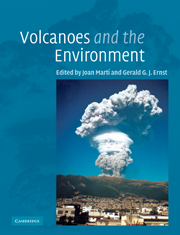Book contents
- Frontmatter
- Contents
- List of contributors
- Preface
- Acknowledgments
- Chapter 1 Understanding the physical behavior of volcanoes
- Chapter 2 Volcano hazards
- Chapter 3 Anticipating volcanic eruptions
- Chapter 4 Volcanoes and the geological cycle
- Chapter 5 Effects of volcanic eruptions on the atmosphere and climate
- Chapter 6 Volcanoes, hydrothermal venting, and the origin of life
- Chapter 7 Volcanism and mass extinctions
- Chapter 8 Effects of modern volcanic eruptions on vegetation
- Chapter 9 Animals and volcanoes: survival and revival
- Chapter 10 Human impacts of volcanoes
- Chapter 11 Volcanoes, geothermal energy, and the environment
- Chapter 12 Volcano-hosted ore deposits
- Chapter 13 Industrial uses of volcanic materials
- Chapter 14 Volcanoes, society, and culture
- Chapter 15 Volcanoes and the economy
- Index
- References
Chapter 3 - Anticipating volcanic eruptions
Published online by Cambridge University Press: 14 November 2009
- Frontmatter
- Contents
- List of contributors
- Preface
- Acknowledgments
- Chapter 1 Understanding the physical behavior of volcanoes
- Chapter 2 Volcano hazards
- Chapter 3 Anticipating volcanic eruptions
- Chapter 4 Volcanoes and the geological cycle
- Chapter 5 Effects of volcanic eruptions on the atmosphere and climate
- Chapter 6 Volcanoes, hydrothermal venting, and the origin of life
- Chapter 7 Volcanism and mass extinctions
- Chapter 8 Effects of modern volcanic eruptions on vegetation
- Chapter 9 Animals and volcanoes: survival and revival
- Chapter 10 Human impacts of volcanoes
- Chapter 11 Volcanoes, geothermal energy, and the environment
- Chapter 12 Volcano-hosted ore deposits
- Chapter 13 Industrial uses of volcanic materials
- Chapter 14 Volcanoes, society, and culture
- Chapter 15 Volcanoes and the economy
- Index
- References
Summary
Introduction
Volcanic activity involves movements of fluids, magma, and vapor, inside the volcano and its feeding systems. These movements will cause external signals, eruption precursors, which may alert us to the proximity of a volcanic event. Such precursory signals can be detected by an adequate volcano monitoring program. Monitoring techniques include a range of geophysical and geochemical techniques, encompassing seismic, ground-deformation, gravity, and magnetic observations, gas monitoring, and remote sensing. Successful forecasting of volcanic events depends on the precision of the surveillance network in detecting any changes in the volcano's current behavior. To interpret the geochemical and geophysical precursors correctly, however, it is also important to understand the physics of the volcanic processes involved in volcanic eruptions. Detailed knowledge of the volcano, its internal structure and style, and potential triggering mechanisms of past eruptions must be combined with adequate monitoring if future volcanic eruptions are to be anticipated and their effects mitigated (Fig. 3.1). In summary, prediction of volcanic activity has the aims of determining when and where a future eruption will occur, and how it will proceed. However, it is also important to understand why the next eruption will occur.
Volcanic eruptions are caused mainly by processes occurring in magma chambers at depth. During the lifetime of the volcano the corresponding magma chamber may change in size and shape.
- Type
- Chapter
- Information
- Volcanoes and the Environment , pp. 90 - 120Publisher: Cambridge University PressPrint publication year: 2005
References
- 6
- Cited by



